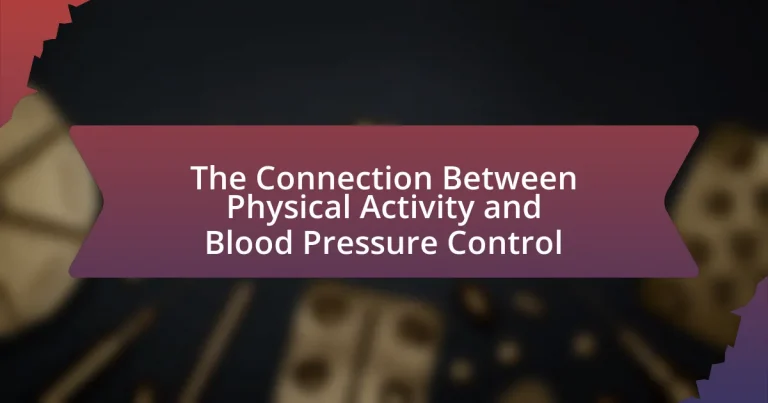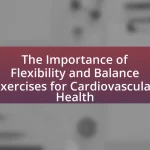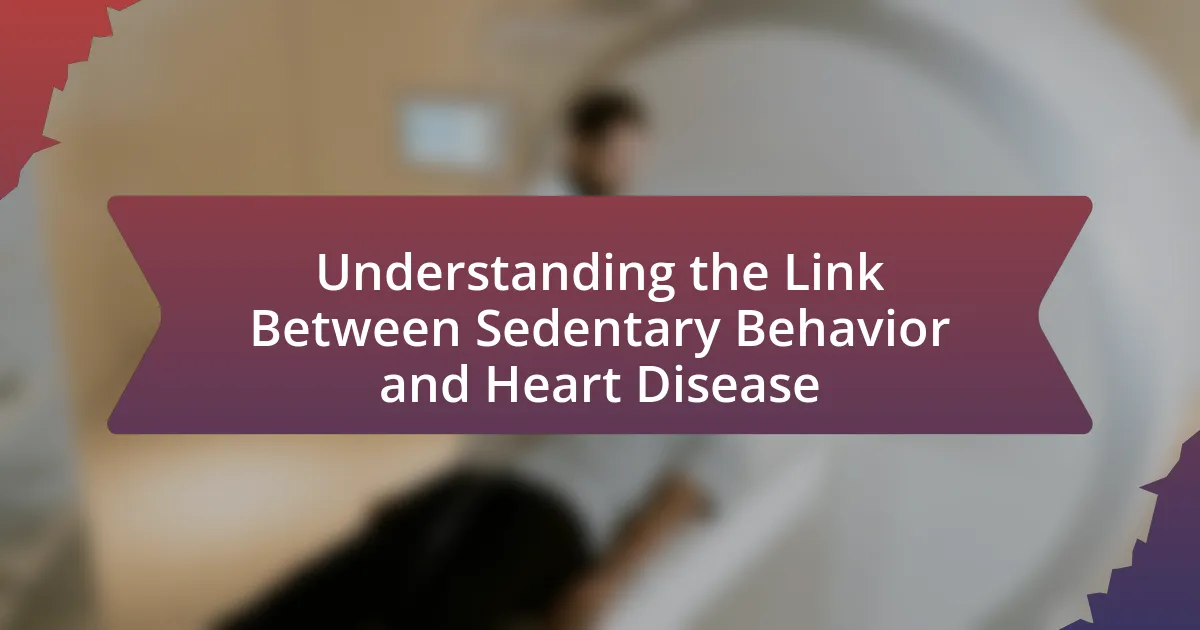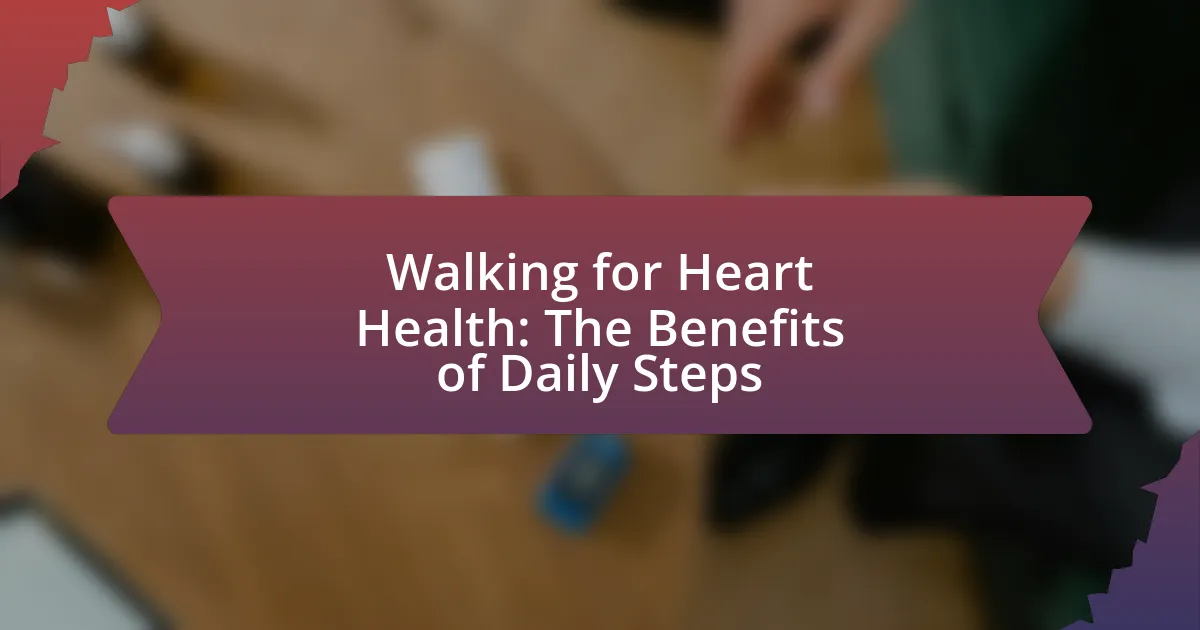The article examines the connection between physical activity and blood pressure control, highlighting how regular exercise can significantly lower blood pressure by improving heart health and enhancing blood vessel function. It discusses the physiological mechanisms through which physical activity influences blood pressure levels, including improved endothelial function and increased nitric oxide production. The article also outlines the recommended types and intensity of exercises, such as aerobic activities and strength training, that are most effective for managing hypertension. Additionally, it addresses the importance of incorporating physical activity into daily routines, the potential risks for individuals with high blood pressure, and the long-term benefits of consistent exercise on overall cardiovascular health.
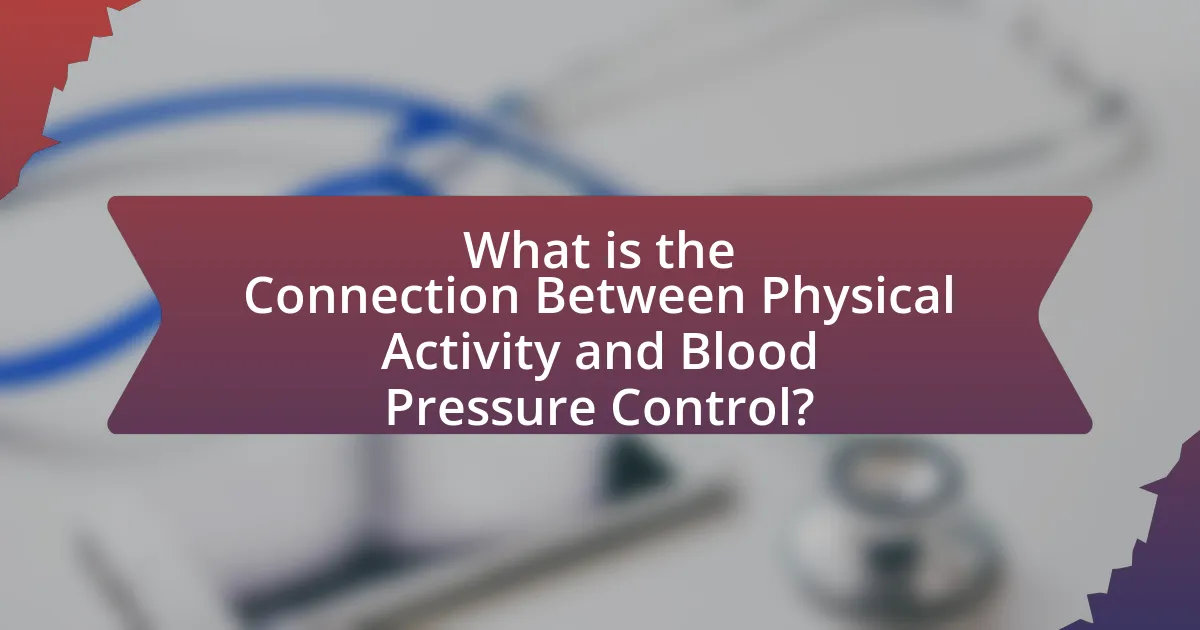
What is the Connection Between Physical Activity and Blood Pressure Control?
Physical activity significantly lowers blood pressure by improving heart health and enhancing blood vessel function. Regular exercise strengthens the heart muscle, allowing it to pump blood more efficiently, which reduces the force on arteries and lowers blood pressure. Studies indicate that moderate-intensity aerobic exercise can lead to a reduction in systolic blood pressure by approximately 5 to 10 mmHg in individuals with hypertension. Additionally, physical activity promotes weight loss and reduces stress, both of which are critical factors in managing blood pressure levels effectively.
How does physical activity influence blood pressure levels?
Physical activity lowers blood pressure levels by improving heart efficiency and promoting better blood flow. Regular exercise strengthens the heart muscle, enabling it to pump blood more effectively, which can lead to a reduction in the force exerted on artery walls. Studies indicate that moderate-intensity aerobic exercise can decrease systolic blood pressure by approximately 5 to 10 mmHg in individuals with hypertension. Additionally, physical activity enhances the body’s ability to regulate blood pressure through mechanisms such as improved endothelial function and reduced arterial stiffness.
What physiological mechanisms link physical activity to blood pressure regulation?
Physical activity regulates blood pressure through several physiological mechanisms, including improved endothelial function, enhanced autonomic regulation, and increased nitric oxide production. Regular exercise promotes the release of nitric oxide, which dilates blood vessels, reducing vascular resistance and lowering blood pressure. Additionally, physical activity enhances the balance between sympathetic and parasympathetic nervous system activity, leading to decreased heart rate and improved vascular tone. Studies have shown that consistent aerobic exercise can lead to a reduction in systolic and diastolic blood pressure by approximately 5-10 mmHg in hypertensive individuals, demonstrating the significant impact of these mechanisms on blood pressure regulation.
How does the intensity of physical activity affect blood pressure?
The intensity of physical activity significantly affects blood pressure, with higher intensity exercise generally leading to greater reductions in blood pressure. Engaging in vigorous physical activity can lower systolic blood pressure by an average of 5 to 10 mmHg and diastolic blood pressure by 3 to 6 mmHg, as supported by research published in the Journal of Hypertension. This effect is attributed to improved cardiovascular function, enhanced blood vessel elasticity, and better regulation of blood flow. Regular participation in moderate to high-intensity exercise is associated with long-term blood pressure control, reducing the risk of hypertension-related complications.
What types of physical activities are most effective for blood pressure control?
Aerobic exercises, such as brisk walking, jogging, cycling, and swimming, are the most effective physical activities for blood pressure control. These activities help improve cardiovascular health by enhancing heart efficiency and reducing arterial stiffness. Research indicates that regular aerobic exercise can lower systolic blood pressure by an average of 4 to 9 mmHg in individuals with hypertension, as noted in a meta-analysis published in the Journal of the American Heart Association. Additionally, resistance training, when combined with aerobic activities, can further contribute to blood pressure reduction, making a comprehensive exercise regimen beneficial for overall cardiovascular health.
Which aerobic exercises are recommended for lowering blood pressure?
Aerobic exercises recommended for lowering blood pressure include brisk walking, jogging, cycling, swimming, and dancing. These activities enhance cardiovascular health by improving heart efficiency and reducing arterial stiffness. Research indicates that regular aerobic exercise can lead to a significant reduction in systolic and diastolic blood pressure, with studies showing reductions of 5 to 10 mmHg in hypertensive individuals after consistent aerobic training. The American Heart Association supports these findings, emphasizing that at least 150 minutes of moderate-intensity aerobic exercise per week can effectively manage blood pressure levels.
How do strength training and flexibility exercises contribute to blood pressure management?
Strength training and flexibility exercises contribute to blood pressure management by improving cardiovascular health and enhancing overall physical function. Strength training increases muscle mass, which can lead to improved insulin sensitivity and reduced arterial stiffness, both of which are beneficial for maintaining healthy blood pressure levels. A study published in the Journal of Hypertension found that resistance training can lower systolic blood pressure by an average of 3-4 mmHg in individuals with hypertension. Flexibility exercises, such as stretching and yoga, promote relaxation and reduce stress, which can also positively impact blood pressure by lowering cortisol levels. Research in the American Journal of Hypertension indicates that regular flexibility training can lead to significant reductions in diastolic blood pressure. Together, these forms of exercise create a comprehensive approach to managing blood pressure effectively.
What are the recommended guidelines for physical activity to control blood pressure?
The recommended guidelines for physical activity to control blood pressure include engaging in at least 150 minutes of moderate-intensity aerobic exercise per week, such as brisk walking or cycling. This recommendation is supported by the American Heart Association, which states that regular physical activity can lower blood pressure and improve heart health. Additionally, incorporating muscle-strengthening activities on two or more days a week is advised, as these can further enhance cardiovascular health and aid in blood pressure management.
How much physical activity is necessary for effective blood pressure control?
At least 150 minutes of moderate-intensity aerobic physical activity per week is necessary for effective blood pressure control. This recommendation is supported by guidelines from organizations such as the American Heart Association, which indicate that regular physical activity can lower systolic and diastolic blood pressure by approximately 4 to 9 mm Hg. Engaging in activities like brisk walking, cycling, or swimming can contribute significantly to these outcomes, promoting overall cardiovascular health and reducing hypertension risk.
What role does frequency and duration play in physical activity recommendations?
Frequency and duration are critical components of physical activity recommendations, as they directly influence the effectiveness of exercise in managing health outcomes, including blood pressure control. The American Heart Association recommends at least 150 minutes of moderate-intensity aerobic activity per week, distributed across most days, to achieve optimal cardiovascular benefits. Research indicates that both the frequency of exercise sessions and their duration significantly impact blood pressure reduction; for instance, a study published in the Journal of Hypertension found that individuals engaging in regular physical activity at least three to five times a week experienced greater reductions in systolic and diastolic blood pressure compared to those who exercised less frequently. Therefore, adhering to recommended frequency and duration guidelines is essential for maximizing the health benefits of physical activity, particularly in the context of blood pressure management.
How can individuals incorporate physical activity into their daily routines for better blood pressure control?
Individuals can incorporate physical activity into their daily routines for better blood pressure control by engaging in at least 150 minutes of moderate-intensity aerobic exercise each week, such as brisk walking or cycling. Regular physical activity strengthens the heart, enabling it to pump blood more efficiently, which can lower blood pressure. Studies indicate that consistent exercise can reduce systolic blood pressure by 4 to 9 mmHg in individuals with hypertension. Additionally, integrating short bouts of activity, like taking the stairs instead of the elevator or walking during breaks, can further contribute to overall physical activity levels and enhance cardiovascular health.
What are some practical tips for staying active throughout the day?
To stay active throughout the day, incorporate short bursts of physical activity into your routine. For example, take brief walking breaks every hour, use stairs instead of elevators, and perform simple exercises like stretching or squats during work breaks. Research indicates that even small amounts of activity can significantly contribute to overall health and help manage blood pressure levels. A study published in the Journal of Hypertension found that regular physical activity can lower systolic blood pressure by an average of 4-9 mmHg, demonstrating the importance of staying active for cardiovascular health.
How can technology assist in maintaining a regular physical activity schedule?
Technology can assist in maintaining a regular physical activity schedule by providing tools such as fitness apps, wearable devices, and online platforms that track progress and set reminders. Fitness apps like MyFitnessPal and Strava allow users to log workouts, monitor their activity levels, and receive personalized feedback, which encourages consistency. Wearable devices, such as smartwatches and fitness trackers, monitor heart rate, steps, and calories burned, providing real-time data that motivates users to stay active. Additionally, online platforms can connect individuals with virtual workout classes and communities, fostering accountability and support. Research indicates that individuals who use technology to track their physical activity are more likely to meet their exercise goals, as evidenced by a study published in the Journal of Medical Internet Research, which found that users of fitness tracking apps increased their activity levels by an average of 30%.
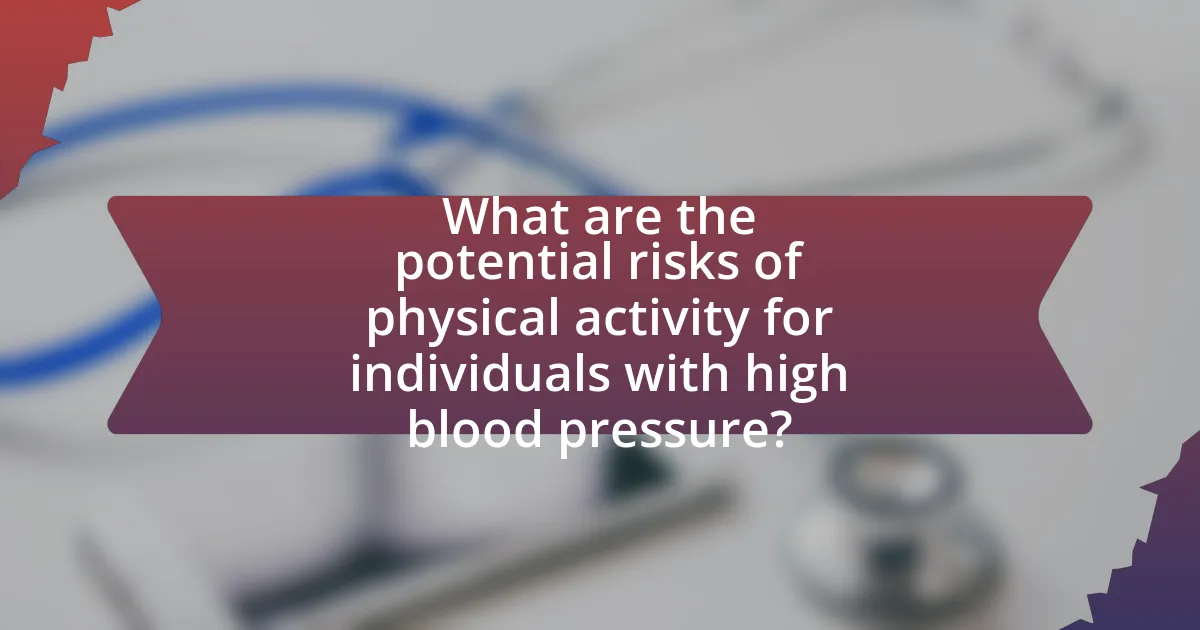
What are the potential risks of physical activity for individuals with high blood pressure?
Individuals with high blood pressure face several potential risks when engaging in physical activity. These risks include the possibility of exacerbating hypertension, experiencing cardiovascular events such as heart attacks or strokes, and suffering from injuries due to overexertion. Research indicates that intense physical activity can lead to acute increases in blood pressure, which may be dangerous for those already diagnosed with hypertension. A study published in the Journal of the American College of Cardiology found that individuals with uncontrolled high blood pressure are at a higher risk of adverse cardiovascular events during vigorous exercise. Therefore, it is crucial for individuals with high blood pressure to consult healthcare professionals before starting or modifying their exercise routines to mitigate these risks.
What precautions should be taken before starting a new exercise regimen?
Before starting a new exercise regimen, individuals should consult a healthcare professional, especially if they have pre-existing health conditions or concerns. This precaution ensures that the chosen exercise plan is safe and appropriate for their specific health status. According to the American Heart Association, individuals with high blood pressure or other cardiovascular issues should undergo a thorough evaluation to determine suitable exercise types and intensities. Additionally, it is crucial to start gradually, monitor body responses, and stay hydrated to prevent adverse effects during physical activity.
How can individuals assess their readiness for physical activity?
Individuals can assess their readiness for physical activity by evaluating their current health status, fitness level, and any existing medical conditions. This assessment can include a review of personal medical history, a physical examination by a healthcare provider, and possibly a fitness assessment to determine cardiovascular endurance, strength, flexibility, and body composition. Research indicates that individuals with pre-existing health conditions, such as hypertension, should consult with a healthcare professional before starting a new exercise regimen to ensure safety and appropriateness of the activity. The American Heart Association recommends that individuals engage in at least 150 minutes of moderate-intensity aerobic activity per week, which can serve as a guideline for assessing readiness based on personal capability and health status.
What signs should individuals watch for during physical activity?
Individuals should watch for signs such as chest pain, shortness of breath, dizziness, and excessive fatigue during physical activity. These symptoms can indicate potential cardiovascular issues or overexertion, which may affect blood pressure control. Research shows that monitoring these signs is crucial for maintaining safety and effectiveness in exercise routines, particularly for those with pre-existing health conditions. For instance, a study published in the Journal of the American College of Cardiology emphasizes the importance of recognizing these warning signs to prevent adverse events during physical exertion.
How can individuals with hypertension safely engage in physical activity?
Individuals with hypertension can safely engage in physical activity by starting with low-intensity exercises, such as walking or cycling, and gradually increasing the intensity as tolerated. Research indicates that moderate aerobic exercise can lower blood pressure and improve cardiovascular health. The American Heart Association recommends at least 150 minutes of moderate-intensity aerobic activity per week for individuals with hypertension. Additionally, it is crucial for these individuals to consult with a healthcare provider before beginning any exercise program to ensure safety and receive personalized recommendations based on their health status.
What modifications can be made to exercises for those with high blood pressure?
Exercises for individuals with high blood pressure can be modified by incorporating low-impact activities, reducing intensity, and increasing duration. Low-impact exercises such as walking, swimming, or cycling minimize stress on the cardiovascular system while still promoting heart health. Reducing intensity ensures that individuals do not overexert themselves, which can lead to spikes in blood pressure. Additionally, longer durations of moderate exercise, rather than short bursts of high-intensity workouts, can be more beneficial for blood pressure management. Research indicates that regular moderate exercise can lower systolic blood pressure by approximately 4-9 mmHg, demonstrating the effectiveness of these modifications in managing hypertension.
How important is medical supervision for individuals with severe hypertension?
Medical supervision is crucial for individuals with severe hypertension. This oversight ensures that blood pressure levels are monitored regularly, allowing for timely adjustments in treatment plans. According to the American Heart Association, uncontrolled severe hypertension can lead to serious complications such as heart attack, stroke, and kidney failure. Regular medical supervision helps in managing these risks effectively by providing personalized care and guidance on lifestyle modifications, including physical activity, which is essential for blood pressure control.
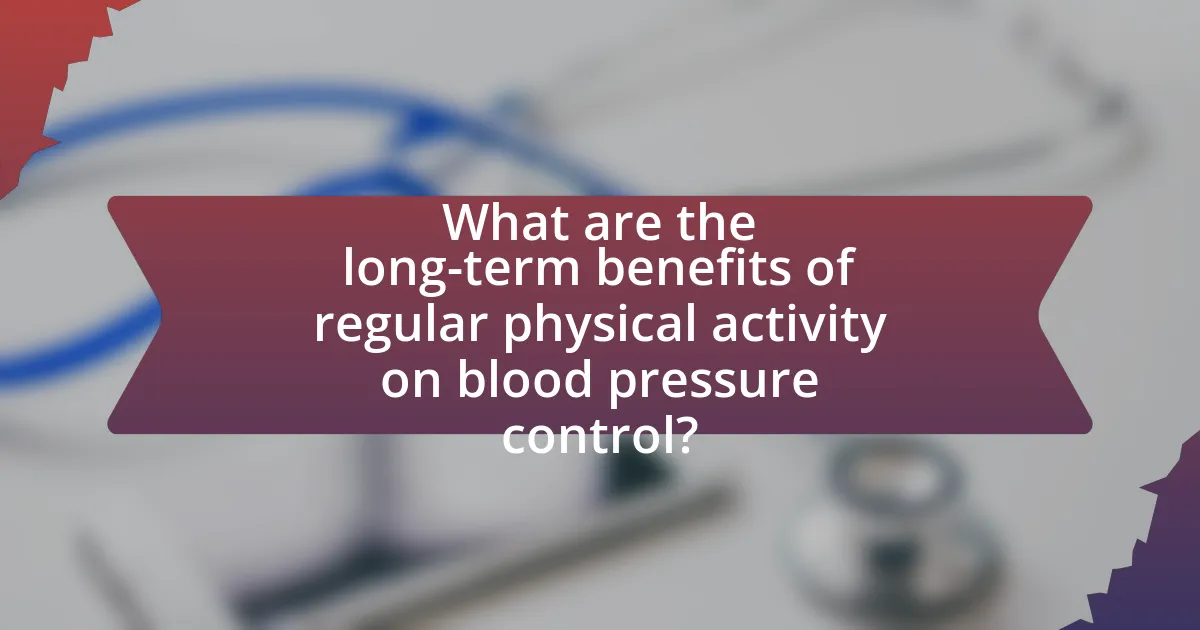
What are the long-term benefits of regular physical activity on blood pressure control?
Regular physical activity significantly lowers blood pressure over the long term. Engaging in consistent exercise helps improve heart health, enhances vascular function, and reduces arterial stiffness, all of which contribute to better blood pressure regulation. Studies indicate that individuals who participate in moderate-intensity aerobic exercise, such as brisk walking or cycling, can experience reductions in systolic blood pressure by 4 to 9 mmHg. Additionally, the American Heart Association states that regular physical activity can lead to weight loss, which further aids in blood pressure control.
How does consistent physical activity impact overall cardiovascular health?
Consistent physical activity significantly improves overall cardiovascular health by enhancing heart function, reducing blood pressure, and improving lipid profiles. Regular exercise strengthens the heart muscle, enabling it to pump blood more efficiently, which lowers resting heart rate and blood pressure. Studies indicate that individuals engaging in moderate-intensity aerobic exercise for at least 150 minutes per week can reduce their risk of cardiovascular disease by up to 30-40%. Furthermore, physical activity helps regulate cholesterol levels, increasing high-density lipoprotein (HDL) and decreasing low-density lipoprotein (LDL), which contributes to healthier arteries and reduced atherosclerosis risk.
What are the psychological benefits of physical activity related to blood pressure management?
Physical activity provides significant psychological benefits that aid in blood pressure management. Engaging in regular exercise reduces stress and anxiety, which are known contributors to elevated blood pressure levels. Studies indicate that physical activity stimulates the release of endorphins, neurotransmitters that enhance mood and promote a sense of well-being, thereby mitigating feelings of depression and anxiety. For instance, a meta-analysis published in the journal “Health Psychology Review” found that individuals who engage in regular physical activity report lower levels of stress and improved mood, which correlates with better blood pressure control. Additionally, exercise can improve self-esteem and body image, leading to healthier lifestyle choices that further support blood pressure management.
How does physical activity contribute to weight management and its effect on blood pressure?
Physical activity significantly contributes to weight management by increasing energy expenditure, which helps create a calorie deficit necessary for weight loss. Regular exercise, such as aerobic activities, has been shown to reduce body fat and maintain lean muscle mass, which is crucial for sustaining a healthy weight. Furthermore, maintaining a healthy weight through physical activity positively impacts blood pressure by reducing the strain on the cardiovascular system. Studies indicate that weight loss of even 5-10% can lead to a noticeable decrease in blood pressure levels. For instance, research published in the Journal of the American Heart Association found that individuals who engaged in regular physical activity experienced a reduction in systolic blood pressure by an average of 4-9 mmHg. This evidence underscores the vital role of physical activity in both weight management and blood pressure control.
What lifestyle changes can complement physical activity for better blood pressure control?
To complement physical activity for better blood pressure control, individuals should adopt a balanced diet, maintain a healthy weight, limit alcohol intake, and manage stress effectively. A balanced diet rich in fruits, vegetables, whole grains, and low-fat dairy products, such as the DASH (Dietary Approaches to Stop Hypertension) diet, has been shown to lower blood pressure significantly. Maintaining a healthy weight is crucial, as obesity is a major risk factor for hypertension; studies indicate that losing even a small percentage of body weight can lead to meaningful reductions in blood pressure. Limiting alcohol intake to moderate levels—defined as up to one drink per day for women and two for men—can also help manage blood pressure. Additionally, effective stress management techniques, such as mindfulness, meditation, or yoga, have been associated with lower blood pressure levels, as chronic stress can contribute to hypertension.
How does diet play a role in conjunction with physical activity for blood pressure management?
Diet significantly influences blood pressure management when combined with physical activity. A balanced diet rich in fruits, vegetables, whole grains, and low-fat dairy, such as the DASH (Dietary Approaches to Stop Hypertension) diet, has been shown to lower blood pressure levels. For instance, research published in the American Journal of Hypertension indicates that individuals adhering to the DASH diet can experience reductions in systolic blood pressure by an average of 8 to 14 mmHg.
Moreover, physical activity enhances the benefits of a healthy diet by improving cardiovascular health and promoting weight loss, which are critical factors in controlling blood pressure. The synergistic effect of diet and exercise can lead to improved endothelial function and reduced arterial stiffness, further aiding in blood pressure regulation. Thus, the combination of a nutritious diet and regular physical activity is essential for effective blood pressure management.
What other lifestyle factors should be considered alongside physical activity?
Other lifestyle factors that should be considered alongside physical activity include diet, stress management, sleep quality, and tobacco use. A balanced diet rich in fruits, vegetables, whole grains, and low in sodium can significantly impact blood pressure levels, as evidenced by studies showing that dietary approaches like the DASH diet can lower blood pressure. Stress management techniques, such as mindfulness and relaxation exercises, have been linked to improved cardiovascular health. Quality sleep is crucial, as insufficient sleep can lead to increased blood pressure; research indicates that adults who sleep less than seven hours per night are at a higher risk for hypertension. Lastly, avoiding tobacco use is essential, as smoking is a well-established risk factor for elevated blood pressure and cardiovascular disease.
What practical strategies can individuals adopt to maintain a physically active lifestyle for blood pressure control?
Individuals can maintain a physically active lifestyle for blood pressure control by engaging in regular aerobic exercise, such as brisk walking, cycling, or swimming, for at least 150 minutes per week. This level of physical activity has been shown to lower systolic and diastolic blood pressure by approximately 5 to 10 mmHg in individuals with hypertension, according to the American Heart Association. Additionally, incorporating strength training exercises at least two days a week can further enhance cardiovascular health and support blood pressure management. Consistency in these activities, along with gradual increases in intensity, helps sustain long-term benefits for blood pressure control.
What are some effective ways to set and achieve fitness goals related to blood pressure management?
Effective ways to set and achieve fitness goals related to blood pressure management include establishing specific, measurable, achievable, relevant, and time-bound (SMART) goals, engaging in regular aerobic exercise, and incorporating strength training. SMART goals help individuals define clear objectives, such as walking 30 minutes a day, five times a week, which has been shown to lower systolic blood pressure by an average of 4-9 mmHg. Regular aerobic exercise, such as brisk walking, cycling, or swimming, can significantly improve cardiovascular health and reduce blood pressure. Additionally, strength training exercises, performed at least twice a week, can enhance overall fitness and contribute to better blood pressure control. Research indicates that a combination of these activities can lead to a reduction in hypertension and improve overall heart health.
How can social support enhance commitment to physical activity for blood pressure control?
Social support enhances commitment to physical activity for blood pressure control by providing motivation, accountability, and emotional encouragement. Individuals who receive social support from friends, family, or community groups are more likely to engage in regular physical activity, which is crucial for managing blood pressure levels. Research indicates that social support can lead to increased exercise adherence; for instance, a study published in the Journal of Behavioral Medicine found that individuals with strong social networks were 42% more likely to meet physical activity guidelines. This support can manifest through shared activities, encouragement, and positive reinforcement, all of which contribute to sustained engagement in physical exercise, ultimately aiding in blood pressure management.
